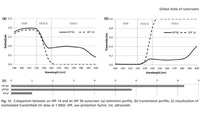Debunking sunscreen myths part 1

As our understanding of the nature and damaging effects of ultra violet (UV) radiation continues to increase, so has the interest and demand in suncare products, resulting in a growing consumer interest.
But, as with most trending topics that capture our interest, it has also captured our imagination. An abundance of information from different sources has resulted in myths about suncare that are often passed off as facts. So through a series of articles, we’ll debunk five common misconceptions around sunscreen.
Myth number one:
According to ‘experts’, the main cause of erythema is UVB rays. Erythema is the redness on the skin, which is the very first indication of overexposure to UV radiation (we might recognise it in its most extreme form as the sun burn we get when we fail to apply sunscreen). It is measured through MED (Minimal Erythema Dose) a measurement of how long it takes for redness to appear on the skin, linking it directly with the SPF factor of a sunscreen because SPF is a concept to measure how well we can prevent erythema (and thus, sunburn).
So, if redness and burning of the skin is caused by UVB rays and not UVA, the assumption spread by this myth is that SPF must therefore only be concerned with blocking UVB rays only, and not UVA.
This misconception has spread far and wide – in 2007 the American FDA even proposed that SPF should be recognised as ‘UVB-SPF’.
Modern science does not agree with this. Trials through BASF’s precise, state of the art sunscreen simulator found that only 80-91% of redness is caused by UVB rays. This means that in fact, redness and burning is not only caused by UVB, but also UVA. Even if we blocked 100% of UVB rays (and no UVA rays), our SPF value could never be more than a mere factor of 11[1]! The facts are clear: if we want our SPF in our sunscreens to be higher to prevent sunburn, it is vital to protect ourselves from UVA just as much as it to protect ourselves from UVB.
Using our sunscreen simulator, scientists here at BASF have found that our sunscreen formula of 5% EHT Uvinul® T 150 and 10% of BDT (fig.12.) can effectively block 100% of UVB rays with the SPF of 14. However, by further simply adding 4% of MBBT (Tinosorb® M), a broad spectrum UV filter with light scattering properties, the SPF of this formula is immediately boosted to 50. From the spectrum chart, we can see that just 4% of MBBT can absorb up to 80-90% of all UVA wavelengths - only a small fraction of 10-20% of all UVA rays are transmitted.

Fact:
So, SPF does not just concern itself with the blocking of just UVB rays but also UVA, as the latter also contributes to erythema and burning of the skin.
[For formulators who want to create sunscreens with high SPF, it is vital to add broad spectrum UV filters to block UVB as well as UVA rays, like MBBT (Tinosorb® M) and BEMT (Tinosorb® S) to boost the SPF of your sunscreen.]
Reference:
1. Sayre RM.,et al. Commentary on “UVB-SPF”: the SPF labels of sunscreen products convey more than just UVB protection. Photodermatol Photoimmunol Photomed 2008; 24:218-220
®/TM Registered trademark. All rights reserved.